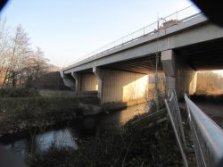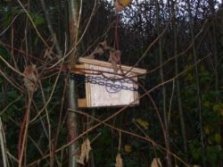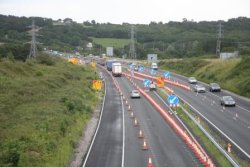M4 Widening Junction 29 (Castleton) to Junction 32 (Coryton) |
|
Whole Project Award
Project Team:
Client: Welsh Assembly Government
(Transport and Strategic Regeneration)
Design: Jacobs
Contractor: Carillion Civil Engineering
Employer’s Agent:
Parsons Brinckerhoff
Environmental Advisors: RML Consult and TACP

The project
The M4 Motorway is a strategically important trunk road providing an east-west link across South Wales. In a broader context, it provides a link with London and the South of England. The section of M4 between Castleton (J29) and Coryton (J32) to the north of Cardiff was originally constructed in the late 1970s. With traffic flows increasing year on year and exceeding predicted flows, this section of motorway has experienced significant congestion and delays, especially at peak times.
The project involved the on-line widening of 13.5km of dual 2-lane motorway between Junctions 29 and 32 by provision of an additional lane in each direction. It was procured through Early Contractor Involvement (ECI) with Partnering philosophy – the first application of this method on a motorway project in Wales.
Design
The design consisted of a combination of symmetrical and asymmetrical widening. Key factors in determining the new horizontal alignment included the need to retain existing overbridges carrying local roads, and the proximity of nearby properties.
In addition, six existing underbridges were widened to maintain the local highway network and accesses. Widening the north side of a river underbridge presented a challenge because of time constraints related to working in the river. An innovative high-level corbel solution was developed which avoided in-river working.
A key objective was to retain, where possible, existing planting and the rural nature of the motorway. To achieve this, extensive use was made of a technique known as soil nailing. This involves the use of steel rods (nails) and mesh to allow steep-angled excavations at the toe of existing cuttings, to provide the additional space required for the widening whilst retaining existing planting at higher levels.
Sustainable Drainage Systems (SuDS) were incorporated in the works, including the provision of ten new attenuation ponds to reduce flows into local watercourses from the widened sections of motorway to the equivalent of greenfield run-off rates. Penstock inlets and outlets were introduced to allow containment of potentially harmful spillages from motoring accidents. During construction, these ponds acted as temporary settlement lagoons to retain any silt from the earthworks and to provide a source of water for dust control.

Landscaping
The M4 corridor traverses through the lower slopes of steeply rising pasture and woodland north of Cardiff. Residential and business development has encroached towards the motorway from the south.
Steepening the lower positions of existing cuttings served to retain substantial lengths of roadside planting and reduced the volume of excavated material to be moved. These steepened slopes were then hydro-seeded using a special mix of grass and wildflowers to maintain the rural setting. Over 100,000 new native trees and shrubs of local provenance were planted to recreate the wooded character of the motorway corridor.
Ecology and protected species
Early surveys showed that the existing motorway plantations and verges were occupied by a number of European and UK protected species, including dormouse, badger, reptiles, bats and otter. Protected species licences were obtained from Welsh Assembly Government and in consultation with the Countryside Council for Wales.
- Dormouse - A scheme to protect these during construction and to provide replacement habitat was implemented.
- Bats - Five species of bats exist on both sides of the motorway and were crossing using a number of bridges and underpasses. Pipistrelles were the most common species. Sensitive design ensured that no roosts or flightlines were adversely affected.
- Reptiles - Slow worm, grass snake and common lizard were found to be using habitat beside the motorway. A programme of capture and relocation had to be completed before construction could commence.
- Otter - Otters were known to be present and using the area’s many watercourses. Riverbanks were protected from damage by the works and, to encourage the spread of otters, a mammal underpass was constructed through an embankment.
- Badger - Badgers were found to be using the motorway land for foraging. Several setts were found within embankment and cutting slopes, with one main sett relocated nearby. Badger-proof fencing was erected to stop future access onto the motorway
Noise and visual impact
In locations were housing had been built close to the motorway, noise barriers were erected and low-noise surfacing used throughout the scheme. Where possible, the retention of existing planting, supplemented by new planting will provide visual screening of the widened motorway.

Innovation
Earthworks - The design aimed to minimise earthwork operations. Introduction of soil-nail-steepened slopes reduced the amount of excavation within cuttings, steepened embankments reduced fill requirements and strategically located environmental mitigation mounds reduced the need to transport material to off-site disposal areas, thereby saving on landfill tax.
Extruded concrete walls - The majority of the concrete retaining walls were constructed using extrusion (slipform) techniques. This involved special plant, fed with fibre-reinforced concrete, travelling slowly along the line of the wall. The cross-section of these walls at the edge of the carriageway means they also act as safety barrier, minimising future maintenance requirements.
Reducing waste and minimising carbon emissions
A number of measures were adopted, including:
- Recycling some 65,000 tonnes of excavated road pavement, most of which was used in carriageway foundation layers.
- Maximising the use of plastic pipes consisting of 80% recycled domestic and industrial waste.
- 30,000 tonnes of locally produced blast furnace slag was used as pipe bedding material for drainage.
- Recovery of redundant safety barrier and communications equipment for recycling.
- 9km of combined kerb and drain units were manufactured entirely from recycled waste material.
- Separation of wastes in the site compound, achieving a recycling rate of over 75%.
- The use of relatively new construction plant on site to maximise fuel efficiency.
- Shredding of tree and undergrowth material for later use as mulch.
- Re-using larger elements (trunks, branches etc) from tree clearance to create reptile hibernacula.
- A locally employed design, contractor and workforce team meant that about 85% of site staff resided in South Wales, helping reduce staff travel.
- Intranet, computer and surveying systems and electronic communication were used in a bid to achieve paperless administration.
Traffic Management
The extended Traffic Management (TM) length, although costly, enabled the construction programme to be reduced by at least six months, reducing the period of disruption for travellers on this section of the motorway.
The contractor’s TM team provided and maintained the temporary traffic layouts, including the contraflow. The layouts were discussed prior to implementation at regular meetings attended by Traffic Wales, the police and other stakeholders. The TM was inspected 24/7 and records made of its condition and any remedial work required. This was essential and important work, given that approximately 70,000 vehicles per day pass through this section of the M4.
In the event of breakdowns, incidents or accidents within the contraflow, the duty TM crew worked closely with Traffic Wales, Police and Emergency Services to ensure traffic delays were minimised. They were called about three times per day, with an average response time of 15 minutes. A free vehicle recovery service was available, which had an average response time of 25 minutes.
Close liaison was maintained during the construction phase with Traffic Wales who used their electronic signs to inform drivers of the TM.

Public Liaison
Throughout the project’s development and construction, public liaison included exhibitions of proposals, distribution of newsletters, meetings with individual landowners and a project website.
The public were kept informed of progress and future activities through newsletters and Traffic Management Information sheets giving advice on restrictions and diversions. Both were delivered to properties and businesses close to the works and directed readers to the project website, which gave more detailed current information.
Regular liaison was maintained with local highway and planning authorities, community councils and regulatory environmental enforcement bodies. These included quarterly meetings with elected and/or other representatives from local authorities and community councils to explain the ongoing work and address any concerns. Similar meetings were held with the statutory environmental regulators.
The contractor carried out various community initiatives as recompense for any disruption caused. Cefn Onn Park was identified as an area which could benefit from a new car park with disabled parking facilities. In addition, a site event was held for a group of girls to visit the site under the Women into Science, Engineering and Construction (WISE) initiative facilitated by Career Wales.
Links

